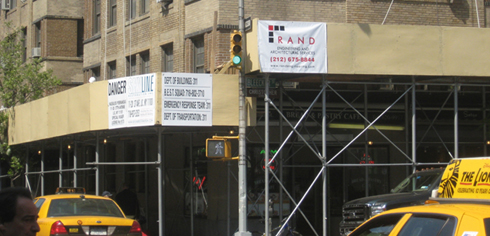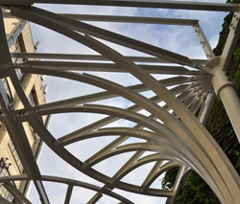As you wend your way through the streets of New York, especially in Manhattan, you can’t avoid walking under or around construction sheds, those ubiquitous steel-and-plywood structures covering large tracts of the city’s sidewalks. Just how ubiquitous are they? According to the Buildings Departments, there are approximately 6,000 sidewalk sheds in New York City, covering more than one million feet (that's 190 miles) of walkways. Chances are, your building has had, now has, or will have a shed installed along its facades during an exterior repair program.
Although sidewalk sheds can be an eyesore—and a nuisance to store owners whose signs and windows they obscure—they are also necessary to protect pedestrians in a city constantly undergoing construction work.

There are approximately 6,000 sidewalk sheds in New York City.
Rand administers dozens of exterior repair and restoration projects each year, the vast of majority of which require a sidewalk shed. We’re often asked if it’s permissible for a shed to extend across the property line of an adjacent building. Not only is it permissible—it’s required. According to New York City building code, a sidewalk shed must extend five feet beyond a building less than 100 feet tall and 20 feet beyond one 100 feet or higher.
In our latest Ask the Engineer column, we look at other common questions and concerns that building owners, managers, and residents have about sidewalk sheds, such as:
- When is a sidewalk shed required?
- How much does a sidewalk shed typically cost to install and maintain?
- Does it make sense to take down the sidewalk shed while the project is on hold or during a winter shutdown?
- What should you do if a shed looks unsafe or has hazardous conditions?

The sleek Urban Umbrella allows in more natural light and visibility.
As for the traditional structure’s bleak appearance, new light may soon be shed on sheds—literally. The Urban Umbrella, a new DOB-approved sidewalk shed design, uses recycled steel columns with splayed spokes, translucent plastic panels, and LED lighting, giving it an sleek, airy look that allows in more natural light and visibility. The first prototype was recently installed in downtown Manhattan.
Check out the full article on our website, and let us know if your building is facing any sidewalk shed issues or if you have comments about the Urban Umbrella. Would your board consider installing the new design in front of your building?
